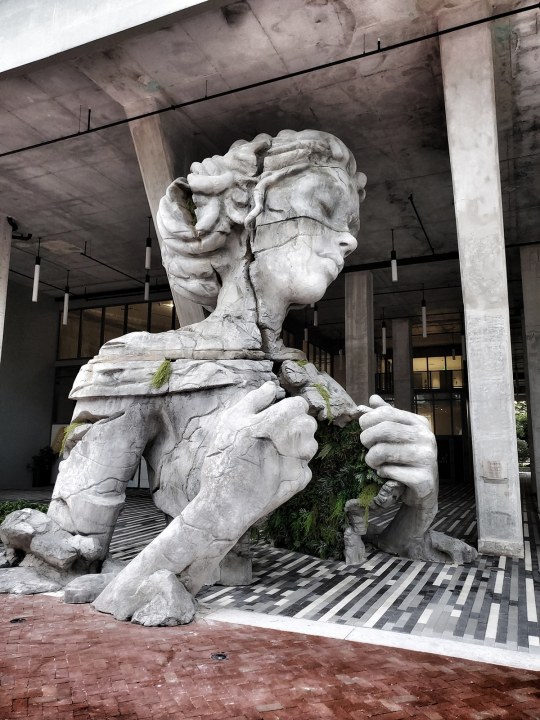Don't wanna be here? Send us removal request.
Link
0 notes
Photo









Embroidery on leaves, great art by Hillary Waters Fayle
36 notes
·
View notes
Link
The frescoes around the front are wonderful.

1K notes
·
View notes
Quote
we are made of 90% water, that doesn’t change and if we remember that… That’s why I like South Dakota in that way because when nature comes into play, when a storm comes in out there, it doesn’t matter what religion you are or what politics you follow, you are going to bundle together to survive.
Chloé Zhao, interview with E. Nina Rothe, https://www.eninarothe.com/faces/2020/1/11/im-constantly-not-on-the-right-side-of-history-an-interview-with-chlo-zhao
0 notes
Photo

The first phase of Project Blue Boy is complete! And in honor of Thomas Gainsborough’s birthday (TODAY) we’re giving you the gift of a Triple B gif (see above. you’re welcome).
During three months of preliminary analysis, Blue Boy was examined and documented using a range of imaging techniques: infrared reflectography (which rendered some paints transparent, making it possible to see preparatory lines or changes the artist made) and ultraviolet illumination (which made it possible to examine and document the previous layers of varnish and old overpaints).


Armed with information gathered from the analysis, co-curators Christina O’Connell (who is also the senior paintings conservator) and Melinda McCurdy mapped out a course of action for treating the painting and developed a series of questions for which they are eager to find answers.

“One area we’d like to better understand is, what technical means did Gainsborough use to achieve his spectacular visual effects?” said McCurdy. “He was known for his lively brushwork and brilliant, multifaceted color. Did he develop special pigments, create new materials, pioneer new techniques? We know from earlier x-rays that The Blue Boy was painted on a used canvas, on which the artist had begun the portrait of a man,” she said. “What might new technologies tell us about this earlier abandoned portrait? Where does this lost painting fit into his career? How does it compare with other earlier portraits by Gainsborough?”
As the conservation process continues, McCurdy also looks forward to discovering other evidence that may become visible beneath the surface paint, and what it might indicate about Gainsborough’s painting practice.
Read about the preliminary findings and 2018 exhibition here.
images:
The Blue Boy (ca. 1770) by Thomas Gainsborough (1727-1788) shown in normal light photography, digital x-radiography (including a dog previously revealed in a 1994 x-ray), and infrared reflectography. Gif’d by The Huntington.
Wearing magnifying glasses, senior paintings conservator Christina O’Connell uses a small light, held at a low angle, to illuminate the surface texture of the portrait of The Blue Boy. The Huntington Library, Art Collections, and Botanical Gardens.
Christina O’Connell (foreground), and Melinda McCurdy, associate curator of British art, with the Nikon UV/POL microscope. The microscope is used for examining tiny samples under high magnification (100–400X) using Ultraviolet and polarized light. The conservator uses the UV/POL scope to examine cross-sections, revealing the layered structure of the painting (often including layers like ground, paint, restorations, and varnish). With polarized light, she can look at samples from discrete layers, like the specific pigments in the paint. The Huntington Library, Art Collections, and Botanical Gardens.
The Blue Boy’s eye is illuminated by the microscope’s lightsource. The microscope, designed for ophthalmology and hand surgery, is on loan from Haag-Streit USA for Project Blue Boy. The Huntington Library, Art Collections, and Botanical Gardens.
157 notes
·
View notes
Link
0 notes
Photo



Thrive Cape Town-based artist Daniel Popper creates monumental public art installations of fantastical figures. His latest work Thrive will be a permanent public installation at Society Las Olas, a residential building in Fort Lauderdale, Florida.
84K notes
·
View notes
Link
“Futurist cooking will be free of the old obsessions with volume and weight and will have as one of its principles the abolition of pastasciutta. Pastasciutta, however agreeable to the palate, is a passéist food because it makes people heavy, brutish, deludes them into thinking it is nutritious, makes them skeptical, slow, pessimistic… Any pastascuittist who honestly examines his conscience at the moment he ingurgitates his biquotidian pyramid of pasta will find within the gloomy satisfaction of stopping up a black hole. This voracious hole is an incurable sadness of his. He may delude himself, but nothing can fill it. Only a Futurist meal can lift his spirits. And pasta is anti-virile because a heavy, bloated stomach does not encourage physical enthusiasm for a woman, nor favour the possibility of possessing her at any time.”
1 note
·
View note


